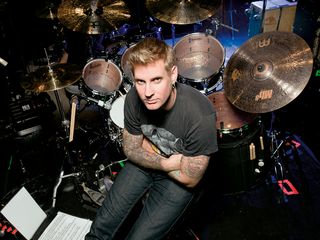
Brann Dailor's drum setup in pictures
Mastodon began leaving their mark on the hard rock world 10 years ago with the release of their first album Remission. Since then, they’ve continued to grow and develop their skills as a band by releasing a string of daring yet critically acclaimed albums.
The latest is The Hunter. It could very well be the album of their career. Chock-full of grooving, catchy songs, the album maintains Mastodon’s proggy style presented in shorter, concise cuts.
One quarter of this musical equation is Brann Dailor. Brann not only handles the complex rhythmic duties of Mastodon but also writes lyrics, arranges songs and sings as well.
Hailing from Rochester, New York, the 36-year-old Brann grew up in a musical household and was exposed to a wide variety of music. This led to getting an early start on drums at the age of three or four.
Brann’s mother and stepfather were in a cover band and he was constantly hearing different music they were learning and playing. That, combined with whatever happened to be on the stereo, gave Brann quite an education.
Although not a schooled player with a formal background, Brann’s musical exposure fuelled his desire to drum.
Previously working with producer Brendan O’Brien on their opus, Crack The Skye, Mastodon took another left turn and worked with noted hip-hop and r’n’b producer Mike Elizondo (who along with Dr Dre has produced tracks for50 cent and Eminem in addition to pop acts Fiona Apple, Pink and Maroon 5).
The result has been met with much approval. Brann’s machine-gun single strokes are as prominent as ever and the drums are powerful and strong in the mix while still supporting the song. Mastodon are currently on tour in the UK in support of the album.
Rhythm recently caught up with Brann to chat about his playing and recording The Hunter. Here we bring you pictures of his kit, along with snippets from that interview, which you can read in full in Rhythm 198. Or you can subscribe to Rhythm Magazine to read interviews with the world’s top drummers each month.
- Find your next setup with our guide to the best drum kits
Next: The kit...
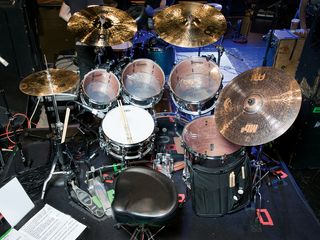
The kit
Tama Starclassic Bubinga: 22x18-inch bass drum; 10x61⁄2-inch, 12x7-inch & 13x7.5-inch toms; 16x16-inch floor tom; 14x6-inch Starphonic brass snare
You’ve used the same set-up over years, is there a particular reason for that?
“I don’t know, I guess I’m just a creature of habit. I get used to a set-up being a certain way. I know there are guys out there that will change it up from time to time to keep it interesting but I just really feel like I have a handle on the way my drums are set up.
“When I write music with the band, I use those configurations so much, if I was to put something else in, I don’t know where I’d use it. I didn’t write the song with it. I would have to change it before writing. Like add a china or something like that.
“I’ve always tried to keep it as simple as possible, but I can’t seem to get rid of the three toms up top. I like having the three toms there. I had a bigger kit when I was 14 or 15 and when we went to play our first gig, I couldn’t fit all the drums into one car, so I had to get a hold of a truck to come over and pick up the rest of the drum kit and bring it to the gig.
“The set-up that I have now was out of necessity back then to be able to fit the drums into one car. That’s why I got rid of the actual double bass that I used to have.
“I had a big Ludwig rocker kit when I was 14. It was massive and wouldn’t fit in one car, so I had to downsize.”
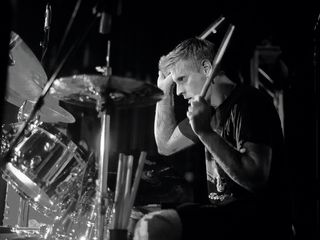
Cymbals
Meinl: 14-inch Mb20 Heavy Soundwave hi-hats; 18-inch Mb20 Heavy crash; 22-inch Mb8 Medium ride; 8-inch Classic Bells Effect cymbal; 20-inch Mb20 Heavy crash
The songs on The Hunter are shorter and more compact. Was that intentional or just the way the writing happened?
“It’s just the way it worked out. I guess it’s sort of a knee-jerk reaction to Crack The Skye, which was really long songs with lots of stuff going on. We wanted to go the other way with it.
“But you can talk all day about what you want to do and then once you start writing, things just start happening. It takes on a life of its own. You have to trust it and follow it wherever it goes and hope for the best. There were a lot of weird, stressful situations happening with people in their lives outside of the band.
“Normally, for a mastodon album, we usually make that a really stressful thing. We’re in there everyday, all day long, banging our heads up against the wall to figure out how to shoehorn these mathematical equations into these songs and it gets pretty intense in there.
“Tempers flare occasionally and people have been known to walk out [laughs]! All’s fair I guess. We get together the next day and go, ‘okay, sorry.’ that’s like eight months of that going on usually, especially for Crack The Skye.
“Trying to put together stuff like ‘The Last Baron’, which is a nightmare, to be honest. It was fun and when you’re finally able to get through the whole song and it feels right and you can play it through for 14 minutes, it feels like you accomplished something.
“This time around, it was really imperative to make sure the practice space was the one place that was stress-free. We could all go there and write music together and have it not be difficult or hard.
“I think that in the past, if we’d come up with a riff, or a series of riffs like in ‘Curl Of The Burl’, we would have said to ourselves, ‘it’s a little too simple. People expect more from us,’ or something like that, but we went with gut reaction. We were satisfied with a simpler version of ourselves.”
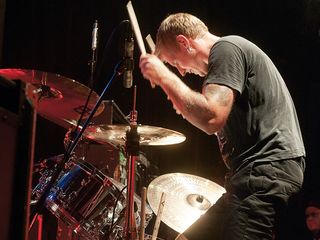
Plus...
Tama hardware including Speed Cobra double pedal, Iron Cobra lever glidehi-hat stand & 1st Chair Ergo Rider drum throne; Vater 5B woodtip sticks; Evans heads: EQ3 clear bass, EQ3 black resonant bass, EQ Pad muffler, AF Patch, Power Center snare batter, 300 snare side, G2 clear tom tops, G1 clear tom bottoms
Is the writing a democratic process?
“It’s democratic. Everyone contributes. It happens a whole bunch of different ways. I could write something at home. Everyone writes a little bit of something at home. Or, we come in and we have one riff or two riffs. Someone else has a riff that goes with that one, something like that.
“I feel like it doesn’t become a Mastodon song until everyone has some input on it. Everyone touches the song in a certain way. It does something different and it brings something different to the table to make it sound like us.
“If it’s just one person by themselves, it doesn’t sound like Mastodon to me. Everyone gets in there and contributes a little bit.”
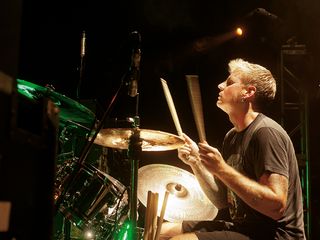
On being a lyrical drummer...
When you are writing lyrics, where does your inspiration come from, and do your lyrics inspire certain drum parts - or is it the other way around?
“I see the way a vocal pattern lies over the top of something as also having a percussive element to it. I try to pick a subject matter for lyric writing but it’s hard because you want things to come to you naturally.
“You don’t want to push for them to happen. I sit down with a song and listen to it over and over again and try to sing something over the top of it. Then I’ll get some sounds going, like some phrasings going. Then I’ll make those into lyrics.
“I’ll say, ‘I can get four syllables into this space.’ that’s how you have to write the lyrics. They have to fit in these little spaces. You have to shoehorn them in there. Then you have to try to make lines one and three rhyme and make lines two and four. It’s really unorthodox but we make it work somehow.”
Now check out Rhythm’s current Issue 198 for interviews with Lamb Of God's Chris Adler and Machine Head's Dave McClain. Or subscribe to Rhythm here for a monthly dose of new gear reviews, kit buying guides, pro drum lessons and all-star interviews.
Liked this? Now read:Drum kits of the pros: stars' live and studio drum setups in pictures
Connect with MusicRadar: via Twitter, Facebook and YouTube
Get MusicRadar straight to your inbox: Sign up for the free weekly newsletter
Most Popular






